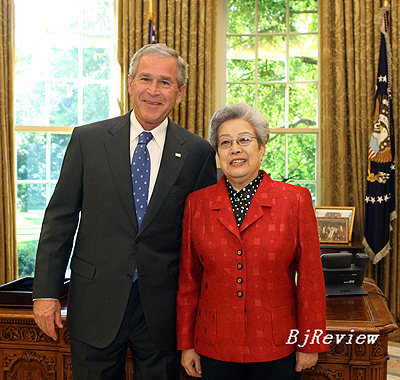
In recent years, trade disputes between China and the United States have seemingly been irresolvable. The two sides have locked horns over U.S. quotas on China's textile exports, charges of infringement on intellectual property rights and the Chinese currency revaluation issue. Now the two countries are back for a fresh round of battle, and this time the focus is on the U.S. hi-tech exports to China that could allegedly have "military uses."
On June 19, the U.S. Department of Commerce implemented new rules concerning hi-tech exports to China; these rules will allow expedited processing for pre-screened, qualified Chinese buyers of general hi-tech goods, but deny exports of "dual-use" products that could contribute to China's military modernization. The list of restricted technology goods covers 20 product categories and associated technologies and software, including aircraft and aircraft engines, avionics and inertial navigation systems, lasers, depleted uranium, underwater cameras and propulsion systems, certain composite materials and telecommunications equipment for space communications or air defense.
China has strongly expressed its "regret and concern" over these tightening controls. In May the two countries held their second Strategic Economic Dialogue (SED) in Washington D.C., during which China urged the United States once again to increase its volume of hi-tech exports in order to help reduce trade deficits on the U.S. side. These new restrictions are now being seen by Chinese authorities as an intentional, provocative move, according to local critics.
"It is inappropriate for the United States to launch these new rules without fully paying heed to what the Chinese side has to say, and it is against the spirit of cooperation," said Yao Shenhong, Spokesman for China's Ministry of Commerce. Yao also said that the new rules would damage China's efforts in increasing imports from the United States and would certainly not be helpful in redressing the bilateral trade imbalance.
Liu Qing, Deputy Director of the Department for American Studies of the China Institute of International Studies, said in Beijing Business Today that China had made several concessions to the United States during the recent SED, promising to purchase $10 billion worth of goods from them and also to further open other fields. However, Liu said, U.S. officials did not seem to be impressed by these efforts and acted completely contrary to what China had expected. He added that the recent move to tighten the control on hi-tech exports to China was "difficult to understand."
Reports from both the Chinese and U.S. media feature a number of analysts who declare that the new rules may aggravate the already troubled bilateral trade relations. Several trade experts have said that trade between China and the United States has always been mutually beneficial and complementary. China has had the advantage in labor-intensive products while the United States has been more competitive in hi-tech and capital-intensive goods. To ease the growing trade imbalance between the two countries, China has advised the United States to increase hi-tech exports.
According to Xinhua News Agency, in 2001, the imports of hi-tech products from the United States accounted for 18.3 percent of China's total hi-tech imports, while the number slid to 9.1 percent in 2006. During these six years, the United States has had a loss of nearly $70 billion trade volume due to its stringent control on hi-tech exports to China.
Facilitating or restricting?
Concerns over possible military uses of some hi-tech products have made the United States reluctant to relax these controls. When the new rules were announced, the U.S. Commerce Department claimed that it intended to facilitate U.S. exports to "legitimate civilian end-users" in China while preventing exports that would "enhance the military capability" of China.
In July 2006, the U.S. Commerce Department's Bureau of Industry and Security (BIS), responsible for the development, implementation and enforcement of the country's "dual-use" commodity export control policy, published a proposed rule requiring licenses for the export of 47 products that had not been previously regulated for the Chinese market. Among them were types of computers, aircraft, semiconductor equipment, navigation systems and telecommunications components. Despite sharp criticism by both the Chinese Government and U.S. exporters, the United States implemented the proposal with some changes to the original draft. The BIS removed individual license requirements for certain authorized customers in China while imposing new licensing requirements on a targeted list of 20 product categories that are said to likely contribute to China's military modernization. The new rule also initiated an authorization requirement for "Validated End User (VEU)," a license that must be obtained for the export, re-export and transfer of eligible items. VEU refers to those entities that meet a number of criteria, including a demonstrated record of engaging only in civil end-use activities. The U.S. Commerce Department said that some sectors are likely to benefit from the VEU initiative, including those of electronics, semiconductor equipment and chemical manufacturers. An initial list of approved VEU buyers is expected to be published as early as July.
| 